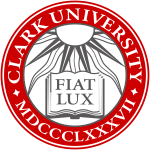
Back جامعة كلارك Arabic کلارک بیلیمیوردو AZB Універсітэт імя Дж. Г. Кларка Byelorussian Universitat de Clark Catalan Clark University DAG Clark University German Universitato Clark Esperanto Universidad Clark Spanish Clarki Ülikool Estonian Clark Unibertsitatea Basque
 | |
| Motto | Fiat lux (Latin) |
|---|---|
Motto in English | "Let there be light" Second motto: "Challenge Convention. Change our World." |
| Type | Private research university |
| Established | March 31, 1887 |
| Founder | Jonas Gilman Clark |
| Accreditation | NECHE |
Academic affiliations | |
| Endowment | $463 million (2023)[1] |
| President | David Fithian[2] |
Academic staff | 341 (2022) - 224 full-time - 113 part-time[3] |
| Students | 3,801 (2022)[4] |
| Undergraduates | 2,389 (2022)[4] |
| Postgraduates | 1,412 (2022)[4] |
| Location | , , United States 42°15′04″N 71°49′24″W / 42.2510°N 71.8232°W |
| Campus | Midsize City, 72 acres (29 ha)[5] |
| Newspaper | The Scarlet |
| Colors | Scarlet White[6] |
| Nickname | Cougars |
Sporting affiliations | NCAA Division III – NEWMAC |
| Mascot | Jonas |
| Website | www |
 | |
Clark University is a private research university in Worcester, Massachusetts, United States. Founded in 1887 with a large endowment from its namesake Jonas Gilman Clark, a prominent businessman, Clark was one of the first modern research universities in the United States.[7][8] Originally an all-graduate institution, Clark's first undergraduates entered in 1902 and women were first enrolled in 1942.[9]
The university offers 46 majors, minors, and concentrations in the humanities, social sciences, natural sciences, and engineering and allows students to design specialized majors and engage in pre-professional programs.[10] It is a member of the Higher Education Consortium of Central Massachusetts, which enables students to cross-register at other Worcester institutions including the Worcester Polytechnic Institute and the College of the Holy Cross.
Clark is classified among "R2: Doctoral Universities – High research activity".[11] It was a founding member of the Association of American Universities, but departed in 1999. The university competes intercollegiately in 17 NCAA Division III varsity sports as the Clark Cougars and is a part of the New England Women's and Men's Athletic Conference. Clark faculty, alumni, and affiliates have included business executives and inventors of the wind chill factor and the birth control pill.[12]
- ^ . U.S. and Canadian 2023 NCSE Participating Institutions Listed by Fiscal Year 2023 Endowment Market Value, Change in Market Value from FY22 to FY23, and FY23 Endowment Market Values Per Full-time Equivalent Student (Report). National Association of College and University Business Officers and Commonfund. 2023. Retrieved February 28, 2024.
- ^ "Office of the President | Clark University". Office of the President. Archived from the original on 2020-09-04. Retrieved 2020-10-04.
- ^ "Common Data Set 2022–2023, Part B" (PDF). Clark University. Archived from the original (PDF) on 2023-01-04. Retrieved 2023-01-29.
- ^ a b c "Common Data Set 2022–2023, Part B" (PDF). Clark University. Archived from the original (PDF) on 2023-01-04. Retrieved 2023-01-03.
- ^ "Our Campus and Location". Clark University.
- ^ "Style guide" (PDF). www.clarku.edu. Archived (PDF) from the original on 2019-07-27. Retrieved 2019-05-16.
- ^ Seim, David L. (2013). Rockefeller Philanthropy and Modern Social Science. Pickering & Chatto Publishers. p. 18. ISBN 978-1-317-31990-0. Archived from the original on 21 December 2016. Retrieved 27 June 2016.
- ^ Leonard, Thomas C. (12 January 2016). Illiberal Reformers: Race, Eugenics, and American Economics in the Progressive Era. Princeton University Press. p. 19. ISBN 978-1-4008-7407-1. Archived from the original on 21 December 2016. Retrieved 27 June 2016.
- ^ "Historical Timeline". Clark University. Archived from the original on 24 June 2016. Retrieved 27 June 2016.
- ^ "Majors, Minors and Accelerated Degrees". Clark University. Archived from the original on 26 June 2016. Retrieved 27 June 2016.
- ^ "Carnegie Classifications Institution Lookup". carnegieclassifications.iu.edu. Center for Postsecondary Education. Archived from the original on 4 October 2020. Retrieved 12 September 2020.
- ^ Kowitt, Beth (18 July 2012). "A founder's bold gamble on Panera". Fortune. Archived from the original on 18 August 2016. Retrieved 27 June 2016.